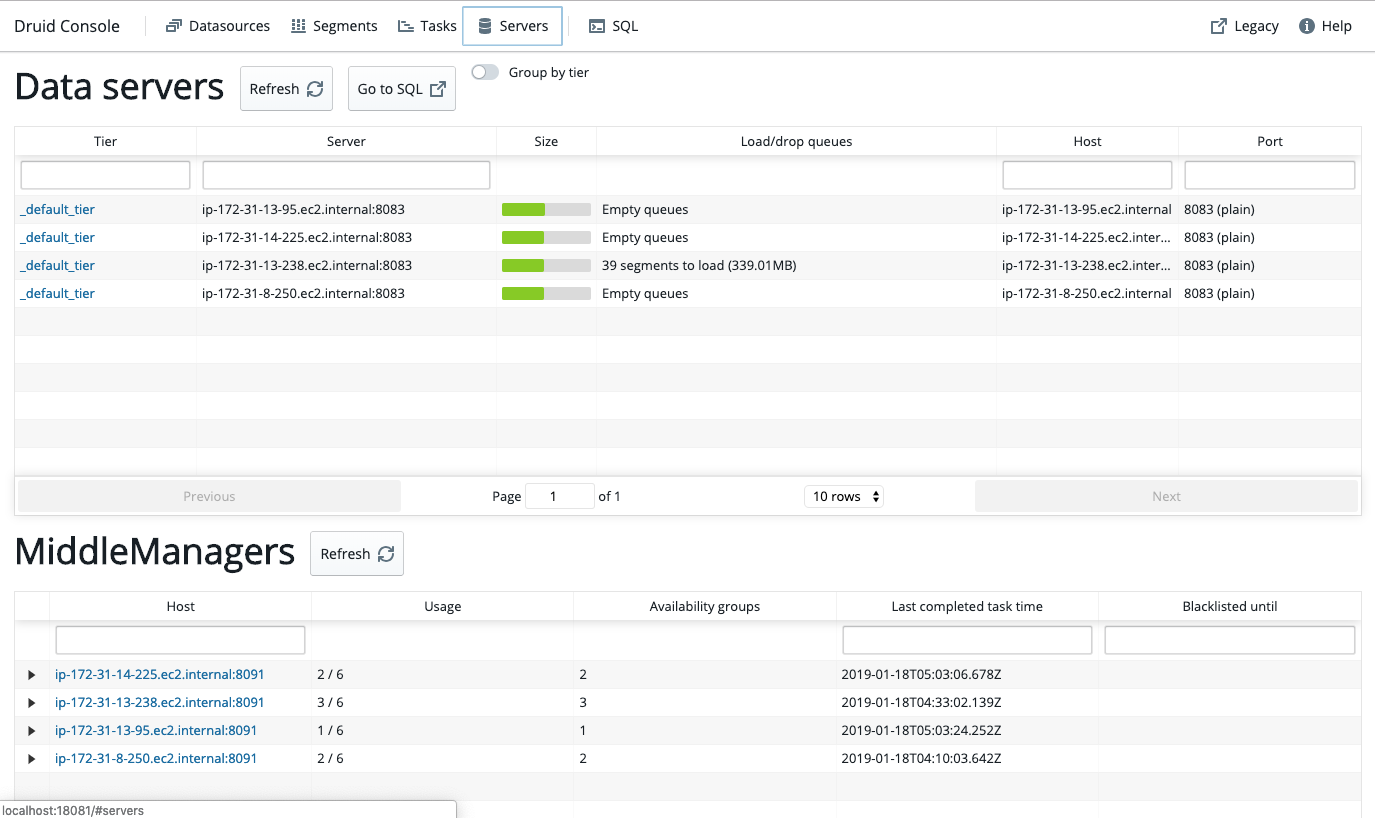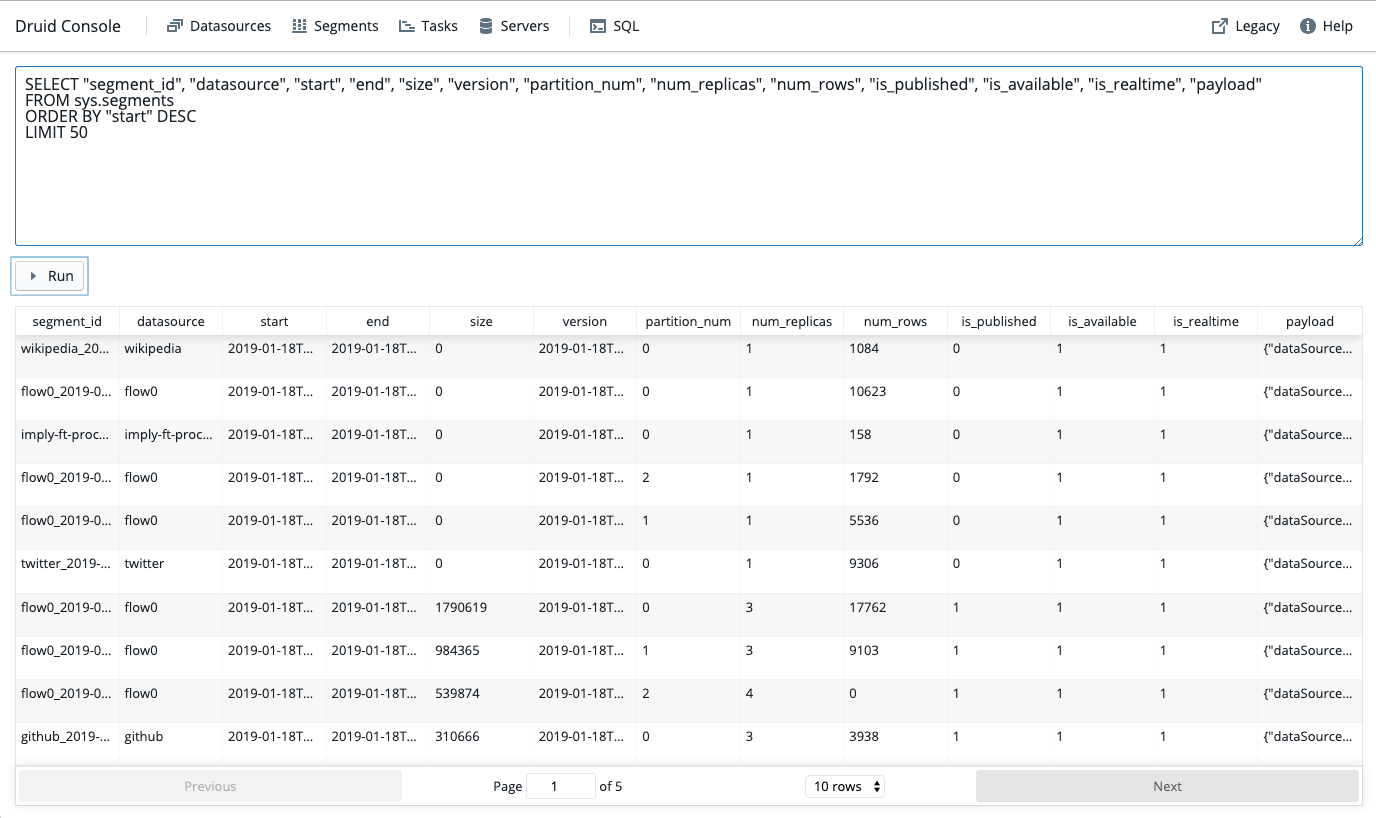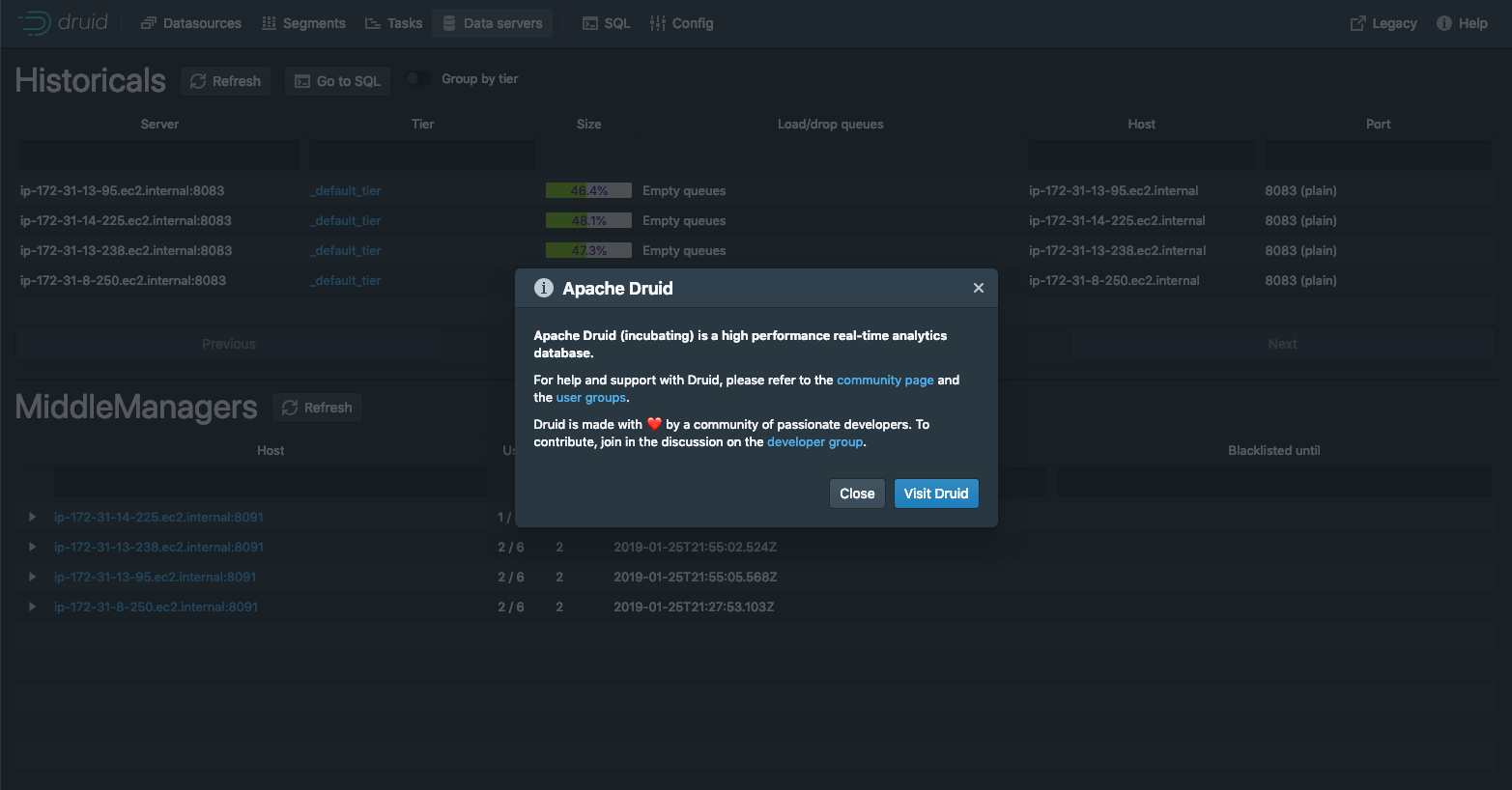-
Notifications
You must be signed in to change notification settings - Fork 3.7k
New issue
Have a question about this project? Sign up for a free GitHub account to open an issue and contact its maintainers and the community.
By clicking “Sign up for GitHub”, you agree to our terms of service and privacy statement. We’ll occasionally send you account related emails.
Already on GitHub? Sign in to your account
[Proposal] "Unified" web console #6832
Comments
|
👍 |
|
We have begun work on this today. In the current version being worked on, most views in the UI are based on system tables, and it is expected that the UI will be hosted on the Druid Router and requires that the Router management proxy is enabled. |
|
while i totally agree and love the idea of unifying the consoles, making (1) router node and (2) sql module mandatory elements is a major limitation IMO.
|
|
@b-slim The tradeoff between incorporating another Druid process (note: Druid nodes are processes and were poorly named by myself and @cheddar) to unify the consoles is worth it, and this is coming from someone that has been the # 1 advocate of reducing processes in Druid. The router requires minimal configuration and there's no other straightforward way of even building a unified console without the router. As someone that created the original coordinator and overlord console, was heavily involved in creating the 2nd gen coordinator console, I can't emphasize enough how much this contribution is needed to make Druid better. Today, you have to go to multiple places to understand where segments are getting built and when they've been finalized. This is a huge pain for initial setup, and debugging segment problems in production is difficult. I've had probably 1000+ conversations about the problems with split consoles and the information that is lacking from them today. This is not to say that reducing Druid processes shouldn't be a goal of the project - as a community I think we should strive to think about how we can merge and simplify processes, but I think today incorporating these changes will make the project better as we continue to work on longer term changes to simplify Druid's architecture. These changes, combined with the repackaging of Druid, will make significant strides to having more adoption, and a much better out of the box experience. Furthermore, debugging issues in production should also become much simpler. Once we reduce Druid's deployment down to 3 server types, each with colocated processes, people will stop focusing on every individual processes and focus much more on server types themselves. |
|
@b-slim with regards to the SQL module - once again, I think the tradeoff is well worth it. System tables have completely changed how people get metadata from Druid, and drastically simplifies operations of the project. They've been tested and validated in production at large scale clusters with minimal impact. |
|
I think @b-slim agrees on that the unified UI is cool, but is concerned about that the router should be set up for the new UI. I think it's a valid concern. The router is currently optional, so it would be not good for someone who wants to use the new UI but doesn't want to run the router. How about adding a new configuration like |
|
I'm on board with that |
I think adding an out-of-the-box UI for some querying functionality (SQL view in this new UI) is pretty great for users, and since the UI would also have the coordinator/overlord console functionality, the router seems like a reasonable place to run the UI. I definitely agree with your point on too many node types; adding to @jihoonson's comment, what do think about eventually combining the router and broker into a process that's positioned as a "unified access point" for the cluster? |
|
As i said i love the idea to consolidate the ui and have less nodes. but to get to that goal i think this UI need to be as part of coordinator (thus we do not create need for router). It seems to me that most of what the UI is serving is part of the coordinator/overlord state thus it makes more sense to me to added it there should rely on the coordinator to construct the timeline or cache it at the coordinator, instead of making ALL the brokers do that duplicate work that has an impact on the query side, also lot of the users don't care about SQL and it will be unfair to make it mandatory on by default. Would love to hear from the original main author how hard it is to by pass the SQL layer and what are the pros/cons ? |
|
I love the idea of a better, unified UI as well. But I also agree with @b-slim on the Router part. We sometimes do quite small, on premise deployments of Druid (think, 1-2 machines) for our clients and adding another node there can actually be a dealbreaker, because of already scarce resources. I know this may be a bit "unorthodox" usage of Druid, but it's real. |
|
@KenjiTakahashi how would you feel if the unified web console ran on the broker node (enabled by a config)? |
|
Or maybe the coordinator? Either way (coordinator or broker) a new proxy route would be needed. |
|
Just for completeness I would also like to throw in the historical node for consideration of where the console might run :-p |
|
@b-slim the new UI serves cluster management, data management, and sql query interface, so I think the router is a good place to add since it's already working as a proxy for overlords, coordinators, and brokers. So, as @jon-wei commented, we can promote it to a unified access point for a Druid cluster. But, I agree that it's not good to make the router mandatory. To avoid that, we can add a new configuration to some module, so that one of mandatory modules can work as a proxy instead. I'm not sure what's the best place to add this configuration to though. From the implementation side, maybe the broker is a good place since it already has a heavy dependency on the coordinator: it gets info about all published & used segments for system table from the coordinator. The coordinator also has some dependencies on the overlord, but they're small. |
|
I think for us the best way would be to leave it in Coordinator. For such small deployments, you can sometimes actually leave out the Broker and just query the Historical directly (as there's only one anyway). But Broker is acceptable, too, I think. BTW: Have to say that the new UI looks quite nice already :-). |
|
Thank you for all the feedback! We are revising the proposal to have the new UI run in two places:
(1) is already done and is a great way to go for someone who wants a unified endpoint for the druid cluster. As people have noted the drawback is that the router is an optional node and should not be required by default. (2) Is the change that a lot of people have advocated for, it will require adding a capability to proxy requests from the coordinator to the broker (for the SQL queries) - we are adding that. Does this make sense to everyone? We are planning on making a blogpost that will go into more details about the new functionality of the UI. Meanwhile here are some screenshots (there has been a lot of style cleanup since the last update): Datasources view:Tasks view:About dialog (over the Data servers view): |
|
I feel like it makes sense to split this proposal into two PRs: adding a new UI to the router and adding a capability to enable routing to the coordinator (or broker). It would be easier to focus on a specific functionality and its implementation. |
|
@jihoonson I agree. This will also make it easier to review. The new console is quite a bit of raw code (as it also embeds into itself the old consoles - all 3 of them). |
We need to ensure that users can index data (via Overlord) and look at the coordinator UI if needed to get what they want about indexing even if the Broker is Not running or does not expose SQL module. |
|
@b-slim I don't think we are replacing the old UIs with the new one in this proposal. People can still use the old ones if they prefer, so we don't have to ensure that right now. In the future, we may want to choose one of them as default. The new UI combines data from multiple sources (coordinator, overlord, and broker enabled SQL) and shows them together. I think this would be really useful for users but it introduces some new requirements (enabling SQL) and dependencies (between the node running the UI and coordinator, overlord, and broker). IMO, this is a sort of trade-off and it's worth to pay the price. Unlike HDFS and Yarn, Druid's indexing, storage, and querying system are tightly coupled with each other, and so it would be really useful for debugging if we can see those information in one page. FYI, when SQL is enabled, the broker starts |
|
@b-slim absolutely, there is no plan here to remove ANY functionality afforded by the older consoles. They will be embedded within the unified console and easily accessible. In fact there are two notifications to make things really clear. One to generally inform people that the old consoles still exist and to smooth the transition: And one to specifically detect the case where the SQL endpoint is disabled: |
|
part (1) of this is now done. Standby for a part (2) followup |
|
Implemented by #6923. |














Motivation
Currently, Druid has three web consoles:
Each one has a distinct design and there are very few cross-links between them. This leads to a disjointed user experience. Also, the fact that the sources for console (1) are not in the Druid repo make it difficult to keep it up-to-date.
A unified console would improve the user experience and would make it easier for Druid developers to keep it up-to-date as Druid's APIs evolve. The change also provides an opportunity to update their design and functionality a bit.
Proposed change
The proposed change is to create a new unified web console that subsumes the functionality of the three existing consoles. The unified UI would have its code live inside the Druid repository, making it easier to keep up to date.
The UI may end up being based on Druid SQL system tables (http://druid.io/docs/latest/querying/sql#retrieving-metadata), which would allow it to be more flexible than a console based on the currently-available coordinator and overlord APIs. The currently-available APIs were designed to support the existing consoles and return exactly what they need to know, but the system tables are more generic, and could power a more flexible new UI. (Imagine being able to show the distribution of data on historical nodes just for a particular datasource -- that kind of thing.) It would also allow the UI to more easily gain new powers as new columns or tables are added to system tables.
Since a unified UI would presumably need to access APIs on both the coordinator and overlord, we would need to either use proxying or CORS to allow that to happen. Proxying makes more sense, imo, since CORS requires extra configuration and some kind of consistent domain, which is not necessarily common amongst Druid deployments (many of which would use raw IPs). It could be hosted on the coordinator if the coordinator makes a proxy available to the overlord and broker. Or, it could be hosted on the router, which can already proxy to the coordinator, overlord, and broker (the former two via the optional management proxy). Or, it could be hosted on a new node type (CliWebConsole?). But we have enough node types already…
New or changed public interfaces
No new or changed APIs, but there would be a new human interface.
Migration plan and compatibility
Keep the existing consoles as-is and offer the new console as a new option. But deprecate the existing consoles and plan to remove them in a future version.
Rejected alternatives
None.
The text was updated successfully, but these errors were encountered: